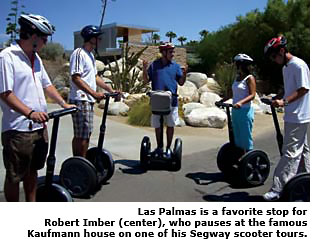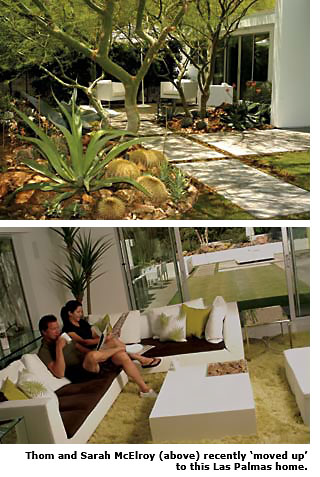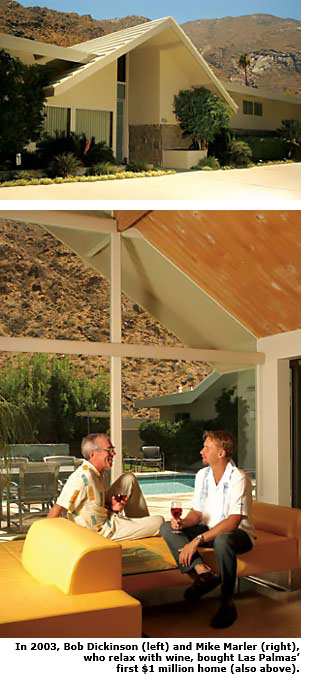The Return of Vista Las Palmas - Palm Springs - Page 2
Residents love gazing at the hills, which provide the neighborhood with an awesome backdrop. Justine Hamilton, a young mother, can enjoy the sight even before stepping out of bed. "You want to wake up," she says, "you want to see the mountains and your pool."

Baeten and his partner Russ Filice, chose their home in part because it looks dead on at Dry Falls, a slick wall of granite that turns anything but dry after a heavy rain. "That's the view everybody wants," Filice says.
They recently sold the home to Thom and Sarah McElroy, who had a home only one block away. But like many people in Palm Springs, they enjoy 'moving up.'
"It's just a nicer house overall, Thom says. "Russ did a complete remodel from the ground up. Every detail has been taken care of."
The neighborhood's proximity to the mountain also helps. "Cooler in summer, warmer in winter," an early sales brochure promised, "the Las Palmas area is relatively free of prevailing winds."
Walking through the neighborhood, California fan palms and mountains often dominate the views. And people do walk, jog, and bike, often in groups. Mothers push strollers. Men walk Cavalier King Charles spaniels. Almost every household in Vista Las Palmas has a dog; many have two.

"It's quiet," Anton says of Vista Las Palmas, "the architecture is appealing, and there's a real sense of neighborhood. It's really, really private."
"We meet people on the street, people we've just met that day," Dickinson says. "We'd say, 'We're having dinner. Come join us.' We would never do that in Los Angeles."
The McElroys, who drive up from Newport Beach with their teenage sons once or twice a month, just enjoy lazing by the pool and dining out. "Just spending good, quality family time," Thom says. "There's something about Palm Springs. You just pull into the city limits, you kind of mellow out. You get peaceful and restful. That's the appeal of it."
Most socializing, everyone says, takes place in people's homes or around their pools, not in restaurants or bars. "It's really about the people," says Mark Ware, a fashion designer who is new to the neighborhood. "It's not about figuring where to go at night, to a club."
Socializing is one aspect of life in Vista Las Palmas that hasn't changed, says Sheila Cobrin, whose parents bought a new home in the neighborhood in the late 1950s—which was still mostly sand—when she was 19. Cobrin, who still lives there, remembers the community hayrides and picnics. "It was a great little city, a village. Everybody knew everybody else," she says. "You'd walk into the restaurant, the night club, it was 'Hello Sheila.' "
Architecturally, the neighborhood is mixed. Most houses are designed by William Krisel of the firm Palmer & Krisel in his mid-century modern language. Krisel designed almost all of the Alexander homes in Palm Springs.
Plans are rectangular and open, with a breezeway separating carport from living area. In their quest for more interior space, residents have filled in all but two or three of the breezeways. Most carports have been turned into garages.

Krisel disguised the uniformity of plan by varying the facades, walls and roofs. You'll find brick walls, wooden screens, and decorative concrete block screens of wide variety—each designed by Krisel. There are butterfly roofs, low-gables, and even a few folded plate roofs.
Some entries open directly onto the walkway, others are recessed, and still others deeply recessed. Some entries disappear beneath trellises, becoming hidden atriums. Homes on hillier sites are sometimes configured as 'L' or 'V' plans.
Not every house in the development is modern, and some that are modern in plan are still not to Krisel's taste. A handful of traditional ranch houses dot the streetscape, as do the Swiss Misses—houses that are based on the Krisel floor plan but stare at the street through steep, double-height A-frame gables that plunge to the ground and recall both Swiss chalets and Fiji tiki-style cabins. They still make Krisel, a purist at heart, shudder.
That's because the neighborhood was not purely an Alexander venture, Krisel says, but a partnership with an investor and longtime builder, J.C. (Joe) Dunas. "Dunas said, 'We should have a variety of homes in that neighborhood, not only modern,' " Krisel says. Bob Alexander objected, but Dunas insisted, so they divvied up the lots, Krisel says.




